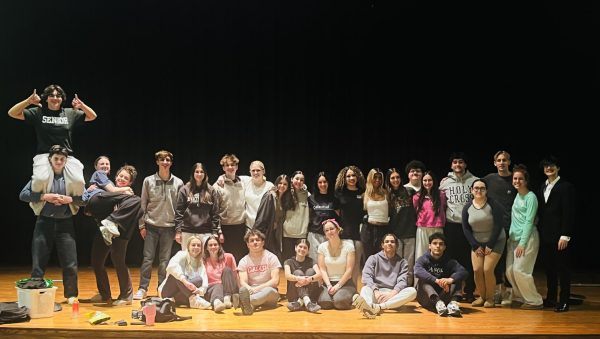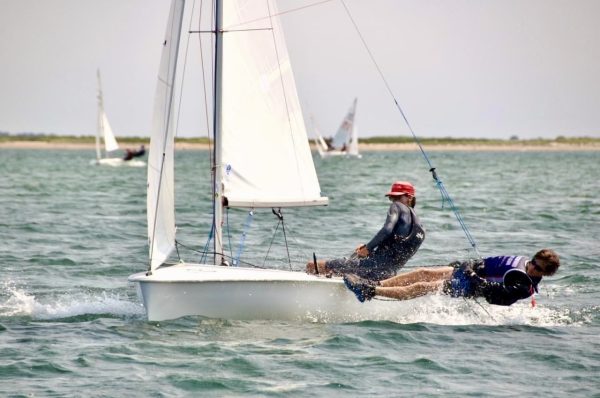Walk It Off: There is more than one way

Walk it off using one of several techniques.
Gym teacher Mark Gaffney does not spend his first period class explaining the rules of basketball or ultimate frisbee. Instead, he teaches his students about a seemingly basic task – walking.
After a five-minute warmup stretch, students spend their remaining 25 minutes walking around the track or in the gym, depending on the weather. They listen to music or talk to friends, some walking briskly while others stick to a leisurely pace.
Walking for Wellness was added to DHS’s wellness curriculum this school year, along with several other new alternatives for Fitness or Sports and Group Games. Mr. Gaffney designed the curriculum, using his knowledge as a certified walking coach.
According to its syllabus, the course is intended to “teach students correct walking techniques, different walking styles, various walking workouts, exercise guidelines associated with different types of walking and how to create a walking group. This will assist students in the development of lifelong physical activity habits.”
The class was created to serve a wider variety of student preferences. “There is a segment of the student population that didn’t want to participate in the sports and games component of the wellness curriculum or the fitness component,” Mr. Gaffney said. “I felt like walking class is a good option for students to get their wellness credit in an activity they’ll want to participate in.”
Senior Marisa Parisi chose Walking for Wellness because of her lack of interest in its alternatives. “I didn’t want to do machines in fitness every day for another year,” she said. “It’s nice to have walking first thing in the morning. It helps you get ready for the day.”
During the first two weeks of the course, students measured their current fitness level by measuring how long it took for them to walk one mile. Their results matched them with a specific exercise program. All but one of the students placed in the beginner program, Mr. Gaffney said.
https://www.instagram.com/p/Bp2rwdnBZnD/?utm_source=ig_web_button_share_sheet
To help them warm up for walking, students learned the difference between dynamic and static stretching and examples of each, said Parisi. For their first benchmark quiz, they had to perform the stretches they had learned. The course consists of three benchmark quizzes, which comply with state standards. Mr. Gaffney often paused his interview to aid students in their quiz preparation, dropping to the floor to demonstrate stretches, including the cobra and the inchworm.
Mr. Gaffney requires the students to stretch prior to walking, due to its health benefits. “It gets the body and legs ready for exercise,” he said. “It prevents injury.” Students also learned the health benefits of walking, such as the prevention of premature death, cancer, and depression.
They have also been taught two of the eleven types of walking in the curriculum – functional and leisure, Parisi said. The others include standing, brisk walking, striding, interval walking, hiking, weighted walking, climbing, treadmill walking, and speed walking.
Each day the students are to journal their walking experience through the app Map my Walk, which measures walking distance, time, and speed. Students typically can only walk a mile and a quarter to a mile and half in the allotted thirty minutes, according to Mr. Gaffney. “We are restricted by the time. If we had the old schedule, we could walk more,” he said.
Mr. Gaffney also aims to provide students with skills they can carry beyond the duration of the course, such as forming a walking group. “They’re going to learn how to create a walking group, how to advertise it with Facebook and Instagram, and the benefits of it,” he said. “That way they could create their own in the spring or summer after the class if they want.”
Aside from the benchmark quizzes, students are graded on their class participation, which includes attitude, preparation, and cooperation.
This is not the first class of its kind. High schools across the country also offer walking as a physical education credit. Some colleges do also, including the University of California Berkeley. Locally, walking is catching on as well. The New Bedford Wellness Initiative hosts a free walking course monthly at Buttonwood Park Zoo. Walking For Calm, a University of Massachusetts Dartmouth’s Counseling Center program, meets weekly to help students destress through walking.
Mr. Gaffney gained his experience in the Walking for Wellness curriculum at the Cooper Institute in Dallas, Texas, which is dedicated to promoting health through research and education programs. He attended a one day program in 2013 to become a certified walking instructor. He found it helpful when constructing Walking for Wellness. “It gave me some credibility,” he said. “This is not just a class where I say, ‘just go out and walk.’ There’s a lot more to it than that.”








